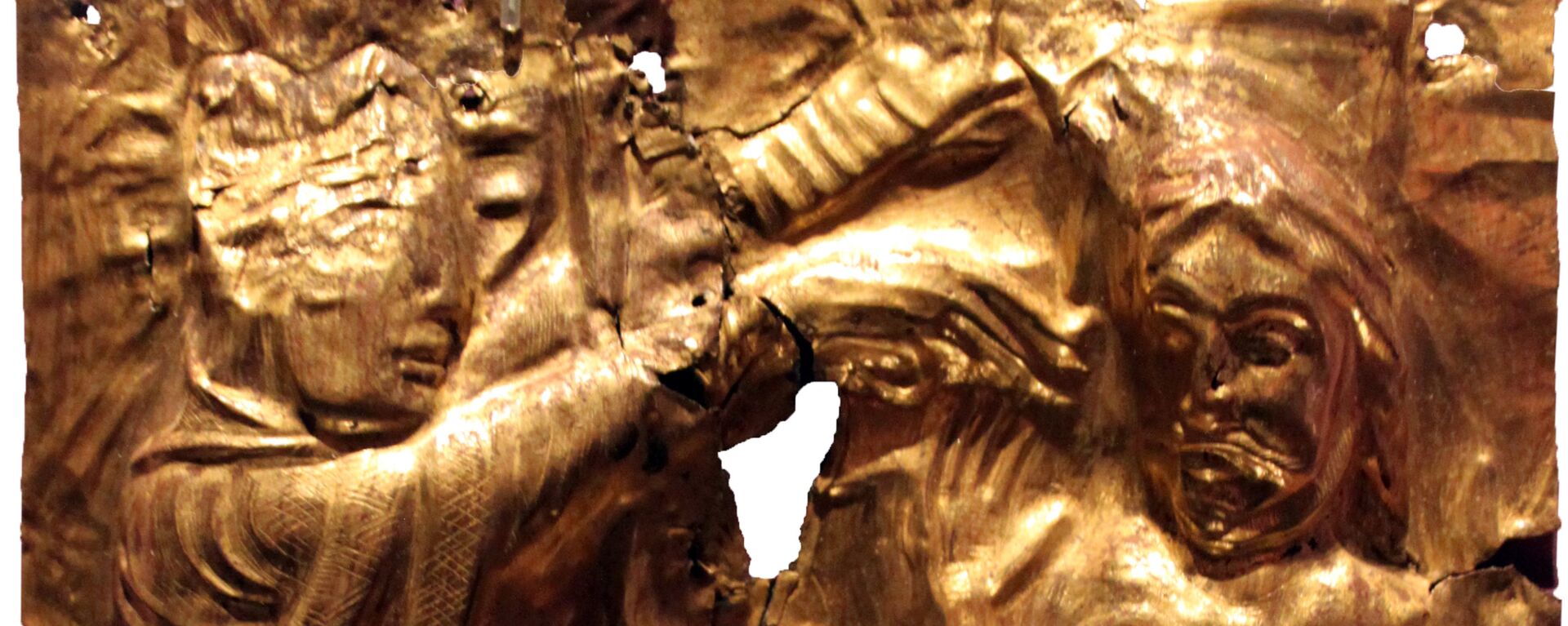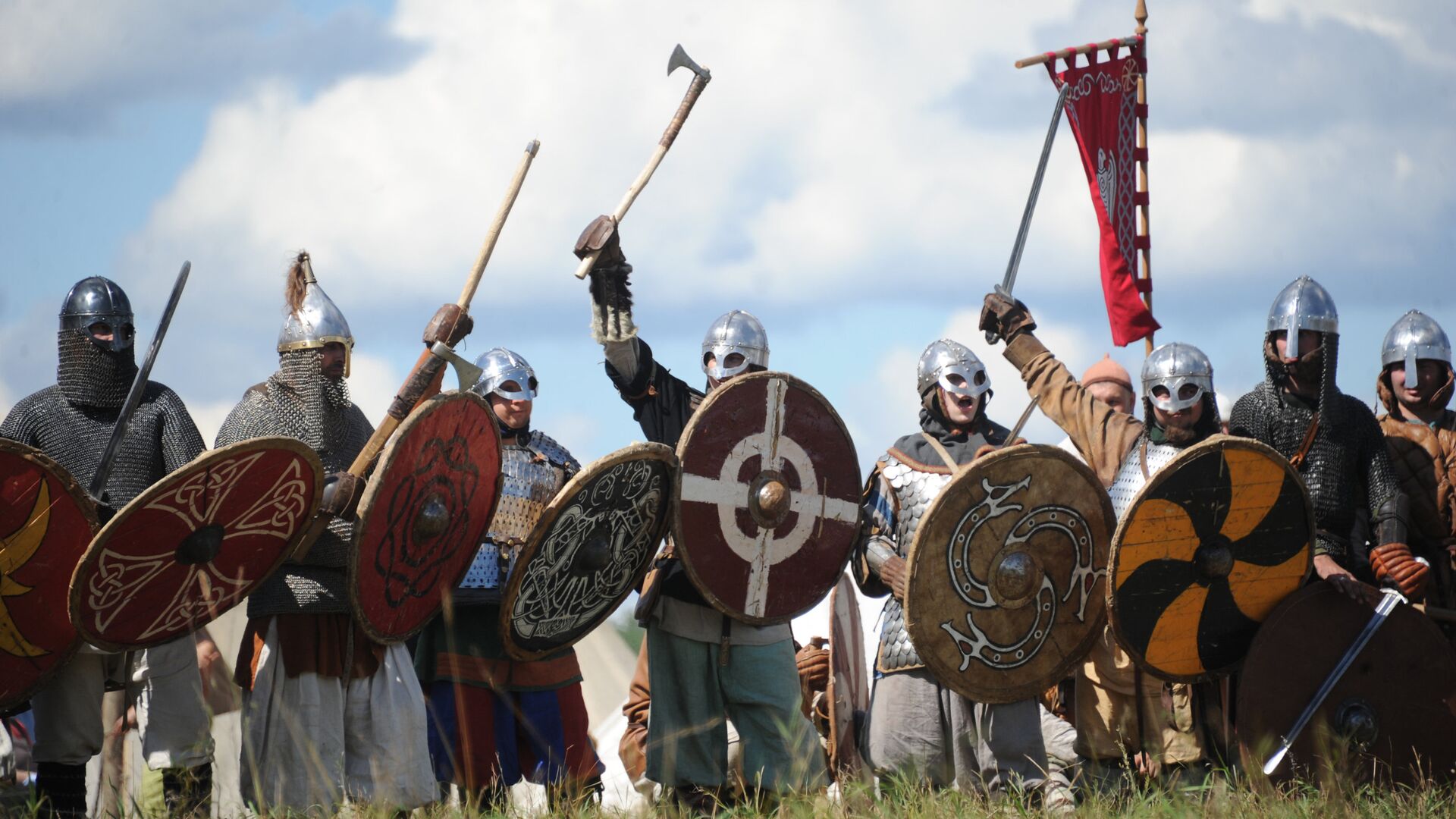https://sputnikglobe.com/20230207/vikings-brought-domestic-animals-to-england-in-bid-to-settle-down-graves-reveal-1107033407.html
Vikings Brought Domestic Animals to England in Bid to Settle Down, Graves Reveal
Vikings Brought Domestic Animals to England in Bid to Settle Down, Graves Reveal
Sputnik International
According to researchers, the presence of domestic animals indicated a change of heart in Vikings and a shift from a pure raid-and-pillage strategy to colonization.
2023-02-07T09:35+0000
2023-02-07T09:35+0000
2023-05-28T15:25+0000
science & tech
vikings
england
archeology
news
europe
united kingdom (uk)
https://cdn1.img.sputnikglobe.com/img/105622/49/1056224989_0:217:3077:1948_1920x0_80_0_0_a2dcd9a98c8adc7d0e2d37ca8405948f.jpg
Findings of Viking Age remains of horse and dog breeds stemming from Scandinavia have shown that domestic animals were fellow travelers during the Vikings' boat journeys to England.While skeletons of humans, horses, dogs, and pigs were found in the Viking graves in Heath Wood, north of Birmingham, before, archeologists have for the first time been able to pinpoint their origin using variations of the element strontium in the remains.Strontium is found in the bedrock and the levels vary in different places in the world. The element is naturally deposited in the skeleton from consumed plants and organic food typical of a certain environment. By examining the variations of the element in the cremated skeletons, it was possible to establish that at least some of the remains were not local.Exactly where in Scandinavia they come from is hard to say. According to Ola Magnell, however, they most likely stemmed from Norway or the west coast of Sweden, more specifically today's counties of Halland, Vastergotland, or Bohuslan."The method has its limitations, but in this case you also have written sources that tell you about this Viking army that arrived in 865. Also, they were buried in a typical Scandinavian grave," Magnell mused.Late 9th century chronicles describe how the Vikings in 865 broke an earlier pattern. This time, they actually settled down instead of simply raiding monasteries and coastal villages.At the end of the 8th century AD, Norseman raiders sacked several Christian monasteries in northern Britain, which marked the start of the Viking conquest. Over the course of the subsequent centuries, Norsemen broadened the scope of their invasions and even founded settlements in many areas in eastern England, Ireland, Scotland, and the Isle of Man.The Viking influence culminated in the appearance of the Danelaw (also known as the Danelagh), a large, yet short-lived territory comprising 15 modern English shires where Scandinavian law and ways were dominant, and receded following the decisive loss of the joint Norse army in the 1066 Battle of Stamford Bridge. However, some parts, such as the Kingdom of the Isles, remained under Nordic rule until the mid-13th century, whereas the last holdouts, such as Orkney and Shetland, were not incorporated into Scotland until 1470.
https://sputnikglobe.com/20230112/giant-viking-hall-possibly-linked-to-king-harald-bluetooth-unearthed-in-denmark-1106243218.html
england
united kingdom (uk)
Sputnik International
feedback@sputniknews.com
+74956456601
MIA „Rossiya Segodnya“
2023
News
en_EN
Sputnik International
feedback@sputniknews.com
+74956456601
MIA „Rossiya Segodnya“
Sputnik International
feedback@sputniknews.com
+74956456601
MIA „Rossiya Segodnya“
viking age, viking conquest, viking activity on the british isles, domestic animals, bone remains
viking age, viking conquest, viking activity on the british isles, domestic animals, bone remains
Vikings Brought Domestic Animals to England in Bid to Settle Down, Graves Reveal
09:35 GMT 07.02.2023 (Updated: 15:25 GMT 28.05.2023) According to researchers, the presence of domestic animals on Viking longships indicated a change of heart and a shift from a pure raid-and-pillage strategy to colonization.
Findings of Viking Age remains of horse and dog breeds stemming from Scandinavia have shown that domestic animals were fellow travelers during the Vikings' boat journeys to England.
While skeletons of humans, horses, dogs, and pigs were found in the Viking graves in Heath Wood, north of Birmingham, before, archeologists have for the first time been able to pinpoint their origin using variations of the element strontium in the remains.
Strontium is found in the bedrock and the levels vary in different places in the world. The element is naturally deposited in the skeleton from consumed plants and organic food typical of a certain environment. By examining the variations of the element in the cremated skeletons, it was possible to establish that at least some of the remains were not local.
"They have quite high values of strontium. Such high values are not found in the area of England where they are buried. However, there are equivalent values in Scandinavia," Ola Magnell, an osteologist and a specialist of animal bones at the National Historical Museums in Sweden told the nation's media.
Exactly where in Scandinavia they come from is hard to say. According to Ola Magnell, however, they most likely stemmed from Norway or the west coast of Sweden, more specifically today's counties of Halland, Vastergotland, or Bohuslan.

12 January 2023, 11:12 GMT
"The method has its limitations, but in this case you also have written sources that tell you about this Viking army that arrived in 865. Also, they were buried in a typical Scandinavian grave," Magnell mused.
Late 9th century chronicles describe how the Vikings in 865 broke an earlier pattern. This time, they actually settled down instead of simply raiding monasteries and coastal villages.
"Certain animals can be brought along for war purposes, such as horses for transport and dogs as guards. But the fact that they brought pigs indicates that they had plans to colonize", Ola Magnell.
At the end of the 8th century AD, Norseman raiders sacked several Christian monasteries in northern Britain, which marked the start of the Viking conquest. Over the course of the subsequent centuries, Norsemen broadened the scope of their invasions and even founded settlements in many areas in eastern England, Ireland, Scotland, and the Isle of Man.
The Viking influence culminated in the appearance of the Danelaw (also known as the Danelagh), a large, yet short-lived territory comprising 15 modern English shires where Scandinavian law and ways were dominant, and receded following the decisive loss of the joint Norse army in the 1066 Battle of Stamford Bridge. However, some parts, such as the Kingdom of the Isles, remained under Nordic rule until the mid-13th century, whereas the last holdouts, such as Orkney and Shetland, were not incorporated into Scotland until 1470.


